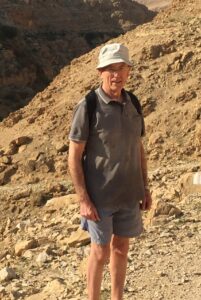Step by Step on the Camino
Walking in Solidarity and Faith to Support Bethlehem University Students
Br. Peter Bray’s Pilgrimage of Solidarity
Br. Peter Bray, FSC, former Vice Chancellor of Bethlehem University is “walking the talk” of solidarity May 23-June 27, 2024.
The El Camino de Santiago in Spain is a pilgrimage of faith to Santiago de Compostela, St. James of the Field of Stars. He is making this pilgrimage to draw attention to the situation in Palestine and to show his solidarity with the Palestinian people and also raising funds to help students at Bethlehem University.
If you’d like to support Br. Peter’s Camino journey by mail outside of the United States or through a home-country giving entity, click here to see various options. Please let us know of your intent to support by emailing Kathy Carver at kcarver@bufusa.org or Shahinda Nassar at shahinda@bethlehem.edu so that credit for this campaign can be assured. Thank you!
Share the Journey
With so many families of students involved in the hospitality industry, and because no pilgrims or tourists are visiting Palestine, there is no income available to those families. In addition, with the checkpoints closed to Palestinian workers who have jobs in Jerusalem, the same applies to those families. This means children of those families who attend Bethlehem University are having serious difficulties paying their tuition. As a result, the University has difficulties paying salaries and running costs. Over a $1 million funding gap exists this Spring.
Br. Peter knows that his successor, Br. Hernán Santos, has walked into a very difficult situation and hopes that this effort will slightly ease the challenges he faces.
Will you walk with Br. Peter, and for our BU students?
Updates From the Road with Br. Peter
Gratitude to All & an End to the Camino Journey!
July 8, 2024
I have come to the end of the Camino! Starting in Pamplona on 23 May I walked for 37 days and covered 730 km. To do that I took 1,270,245 steps, according to my phone! As I sit and look back on that time, I am confronted with a host of amazing memories. Some are memories…
Pedrouzo, the Last Stop before Santiago!
July 1, 2024
Greetings this time from Ponferrada, a city of some 70,000 people, well to the west of Pamplona where I began this Camino Walk. I am currently well over the 900,000 steps and in the course of next week I will reach 1 million steps. It has been great to pass the 400 km to go milestone, then the 300 km to go. The accompanying photograph shows that I have now passed the 200 km to go milestone!
900,000 Steps and Counting!
June 24, 2024
Greetings this time from Ponferrada, a city of some 70,000 people, well to the west of Pamplona where I began this Camino Walk. I am currently well over the 900,000 steps and in the course of next week I will reach 1 million steps. It has been great to pass the 400 km to go milestone, then the 300 km to go. The accompanying photograph shows that I have now passed the 200 km to go milestone!
 What is the Camino?
What is the Camino?
Pilgrims worldwide have travelled to Santiago since the 10th century to atone for their sins and visit the tomb of St. James, allegedly buried in Santiago’s magnificent cathedral.
The Camino de Santiago, alternatively recognized as the Way of St. James, comprises a labyrinth of age-old pilgrimage pathways culminating in Santiago de Compostela. Historically, pilgrims commenced their journey from their place of residence, yet presently, the commonly acknowledged starting point is the town of Saint-Jean-Pied-de-Port, situated just beyond the French border. Termed as the Camino Francés or French Way, the primary path traverses over 790km (490mi) through the northern expanse of Spain. For over a millennium, the Camino de Santiago has served as a sacred pilgrimage path, with indications of its existence even before the advent of Christianity. Its roots trace back to a former Roman trade route, affectionately dubbed the Milky Way for its alignment with the galaxy’s trajectory, leading travelers to what was perceived as the Earth’s edge.
According to Christian tradition, Santiago, also known as Saint James, one of the original twelve apostles, played a pivotal role in propagating Christianity across the Iberian Peninsula. Legend has it that upon his death, his disciples transported his remains by boat, which eventually arrived on the shores of Spain, near the present location of Santiago de Compostela. Another account suggests that centuries later, a Galician farmer stumbled upon his body near the town of Padrón. Regardless of the narrative, it is believed that King Alfonso II commanded the burial of the relics in a purpose-built chapel, later evolving into the renowned Santiago de Compostela Cathedral, drawing pilgrims from all corners of Europe.
